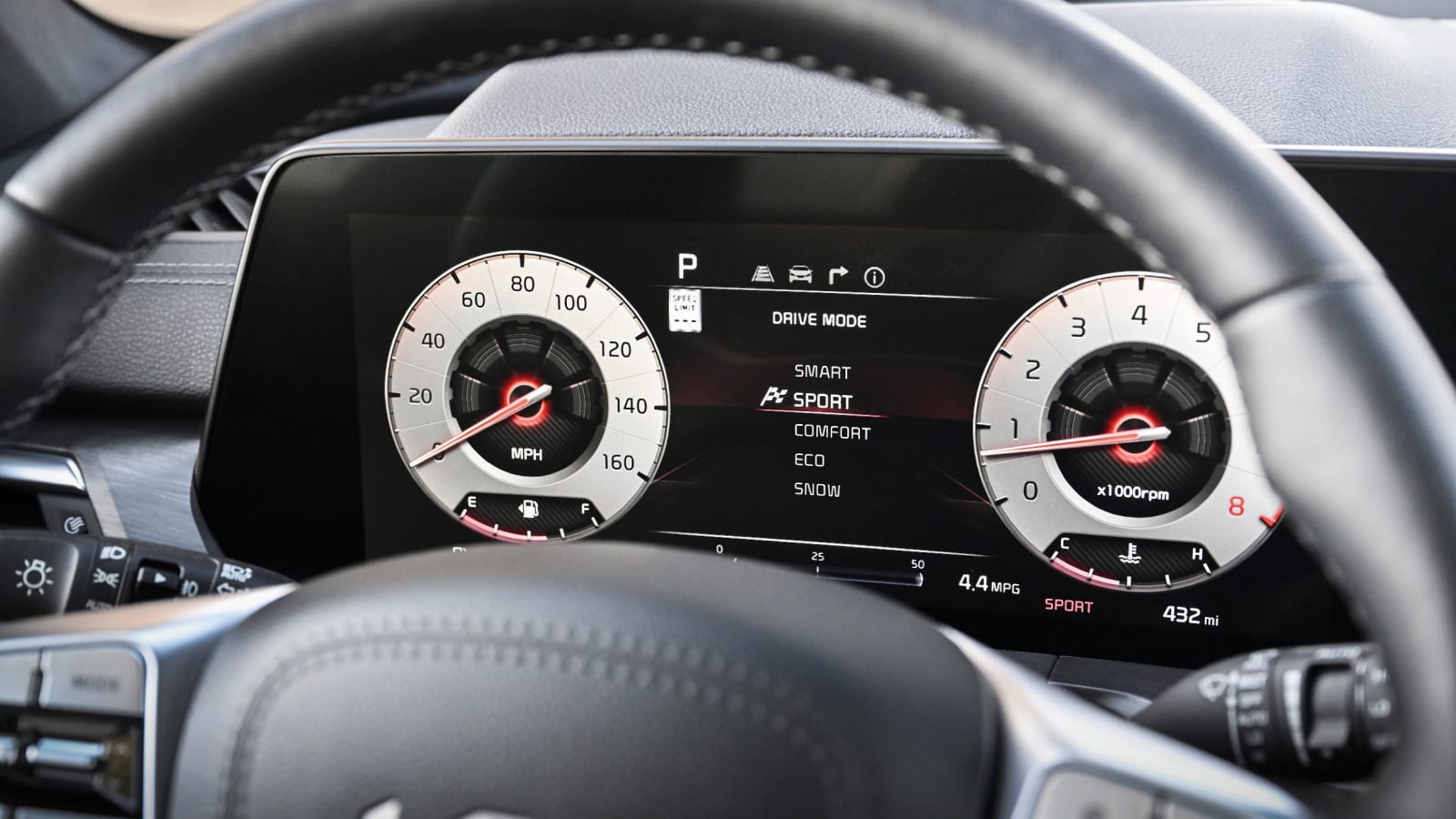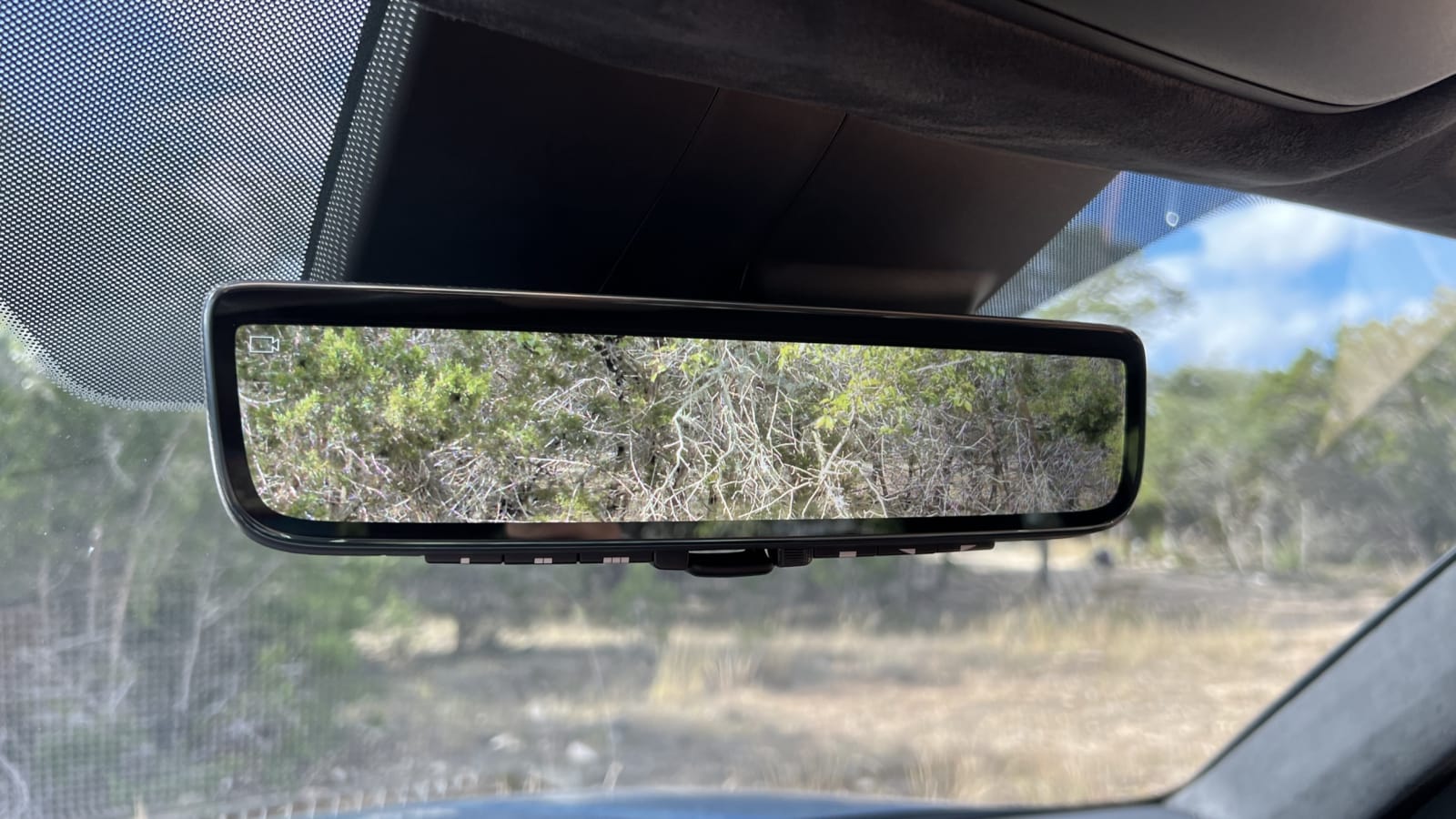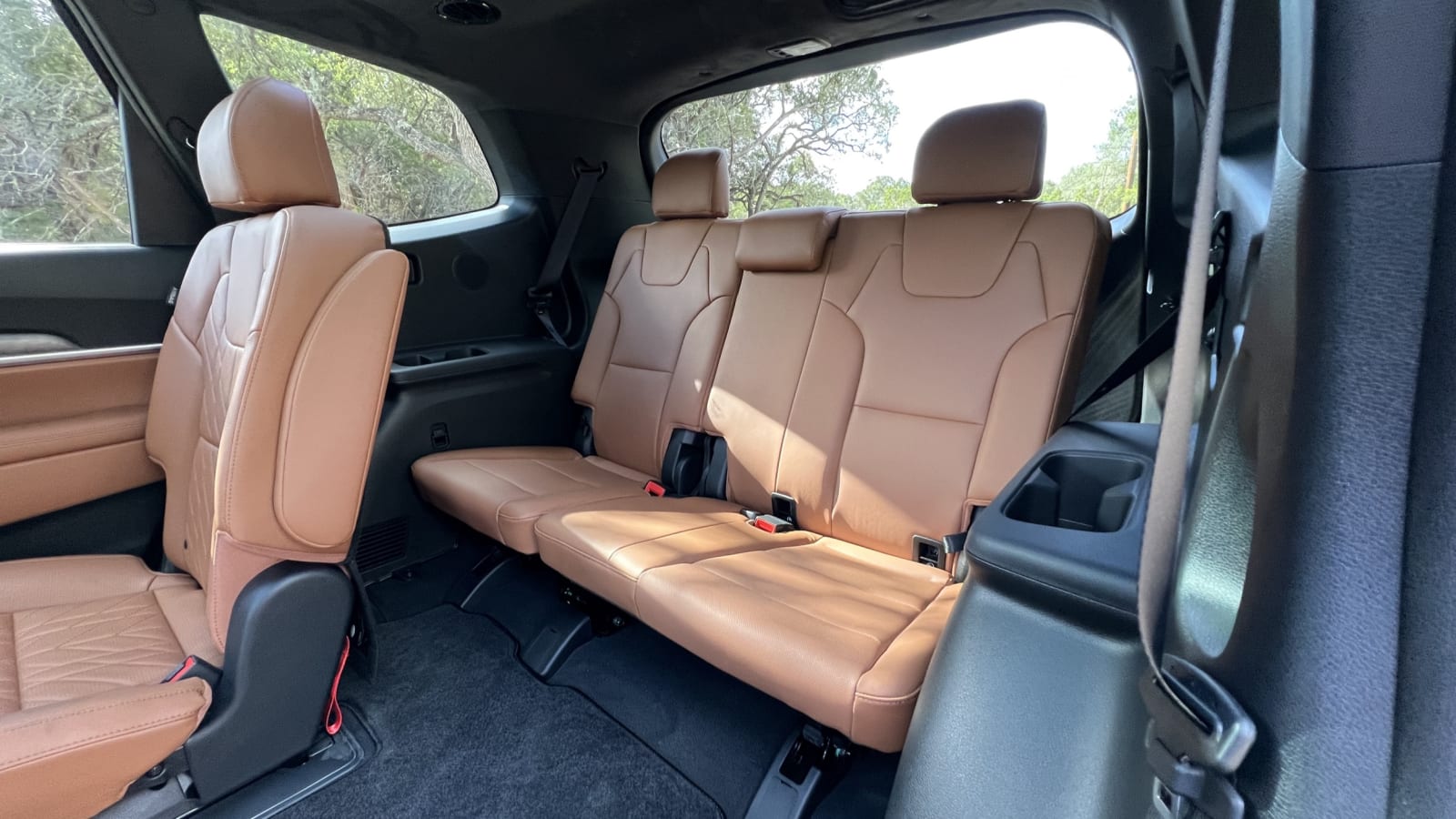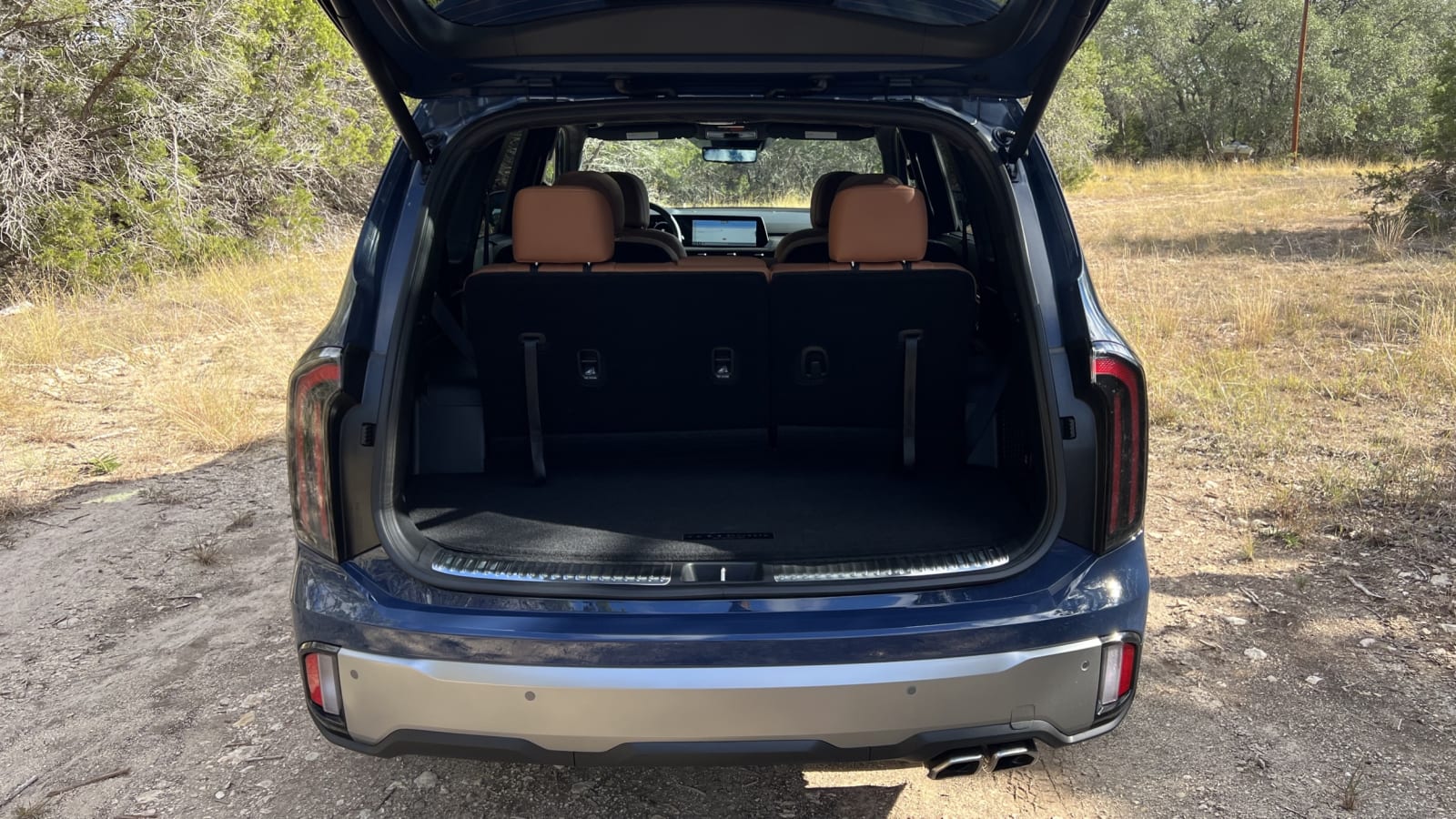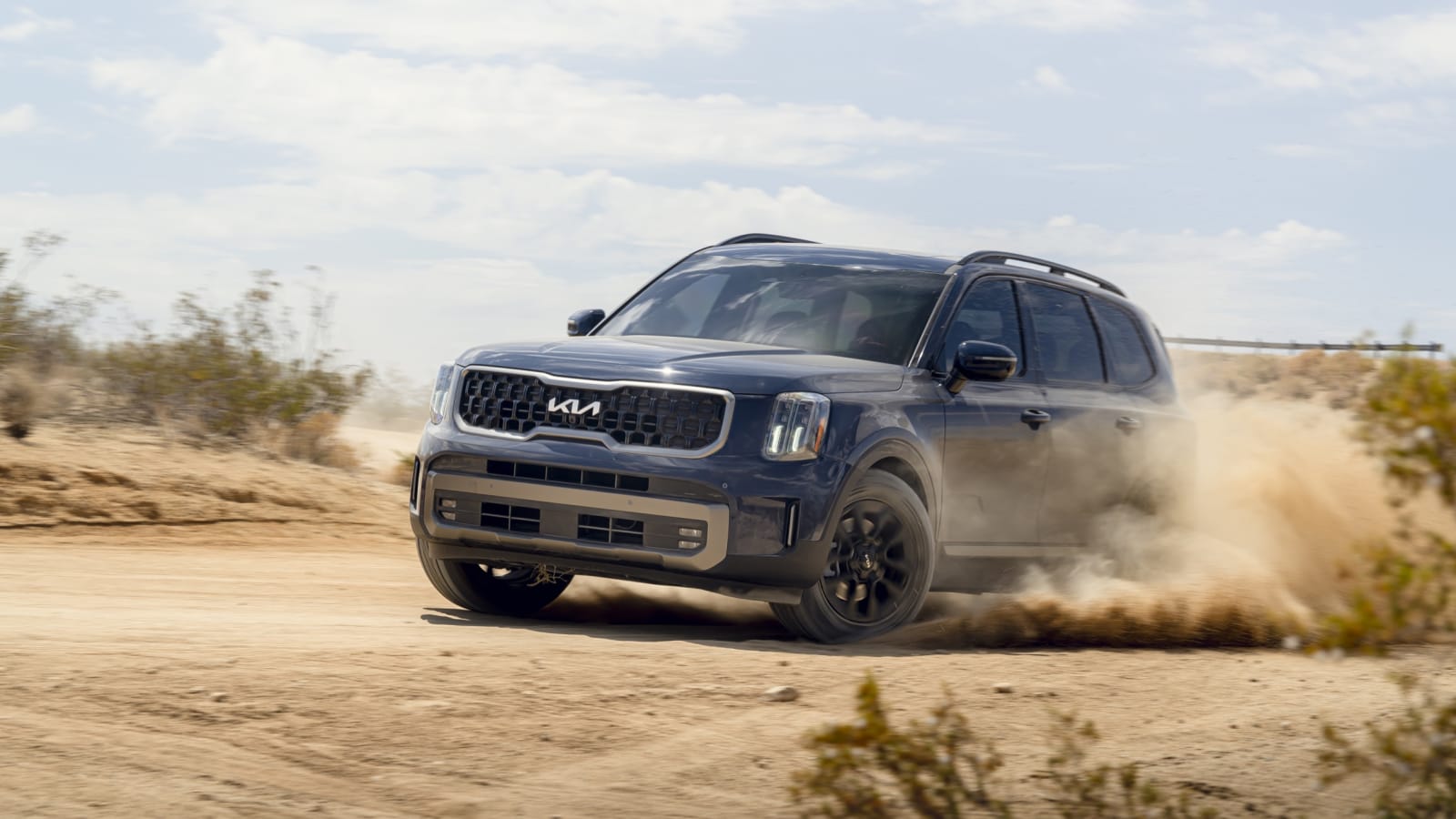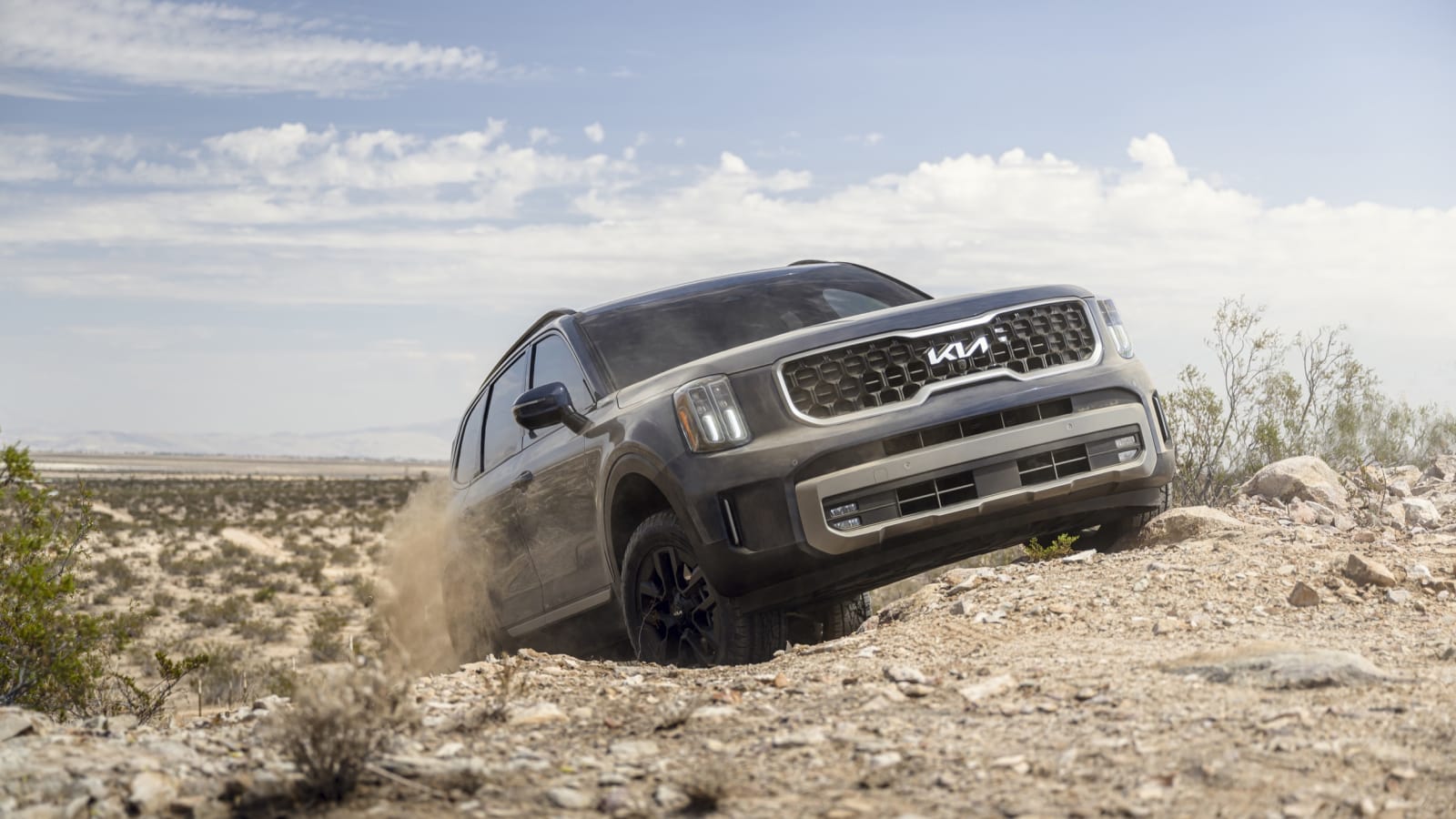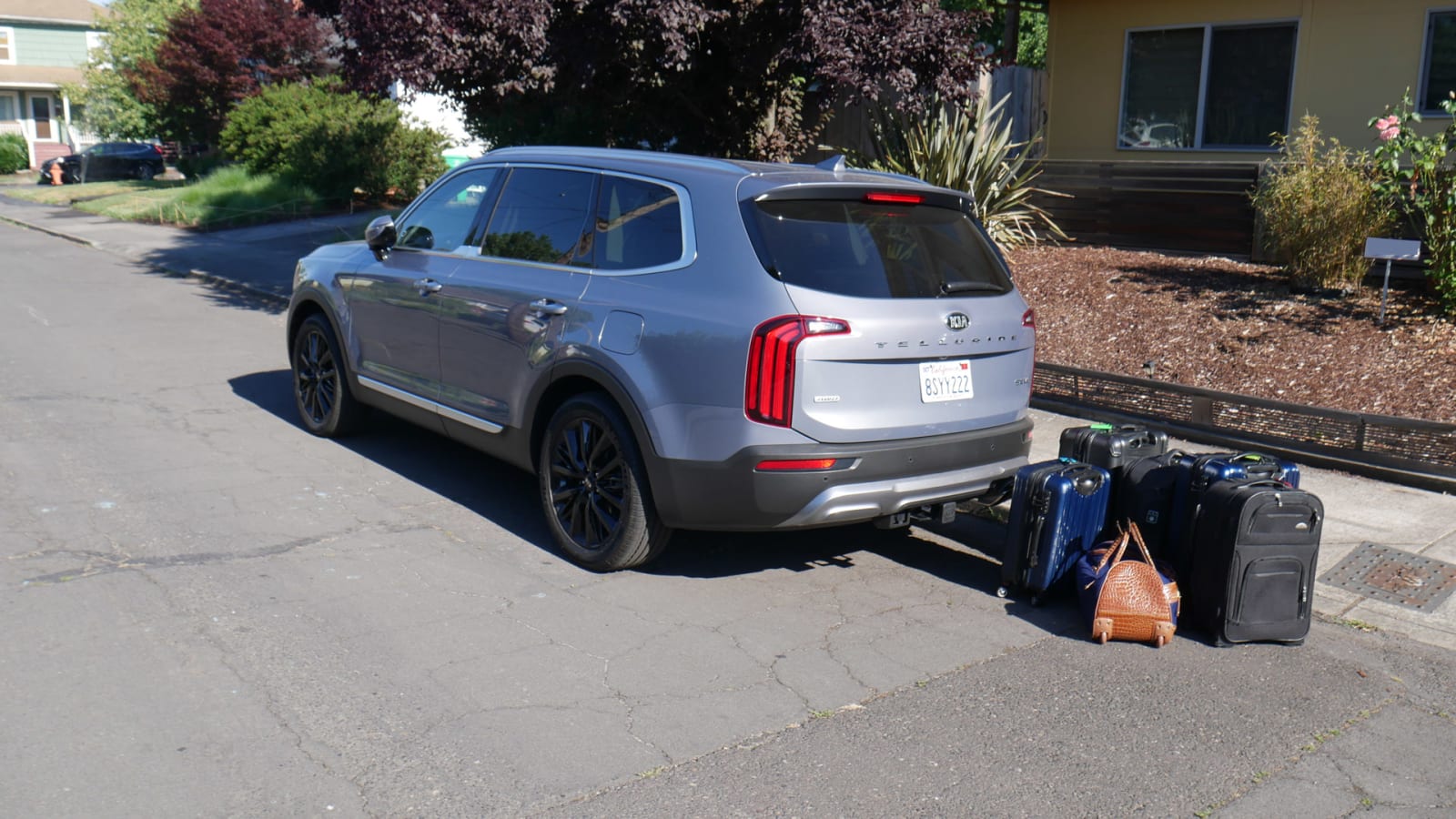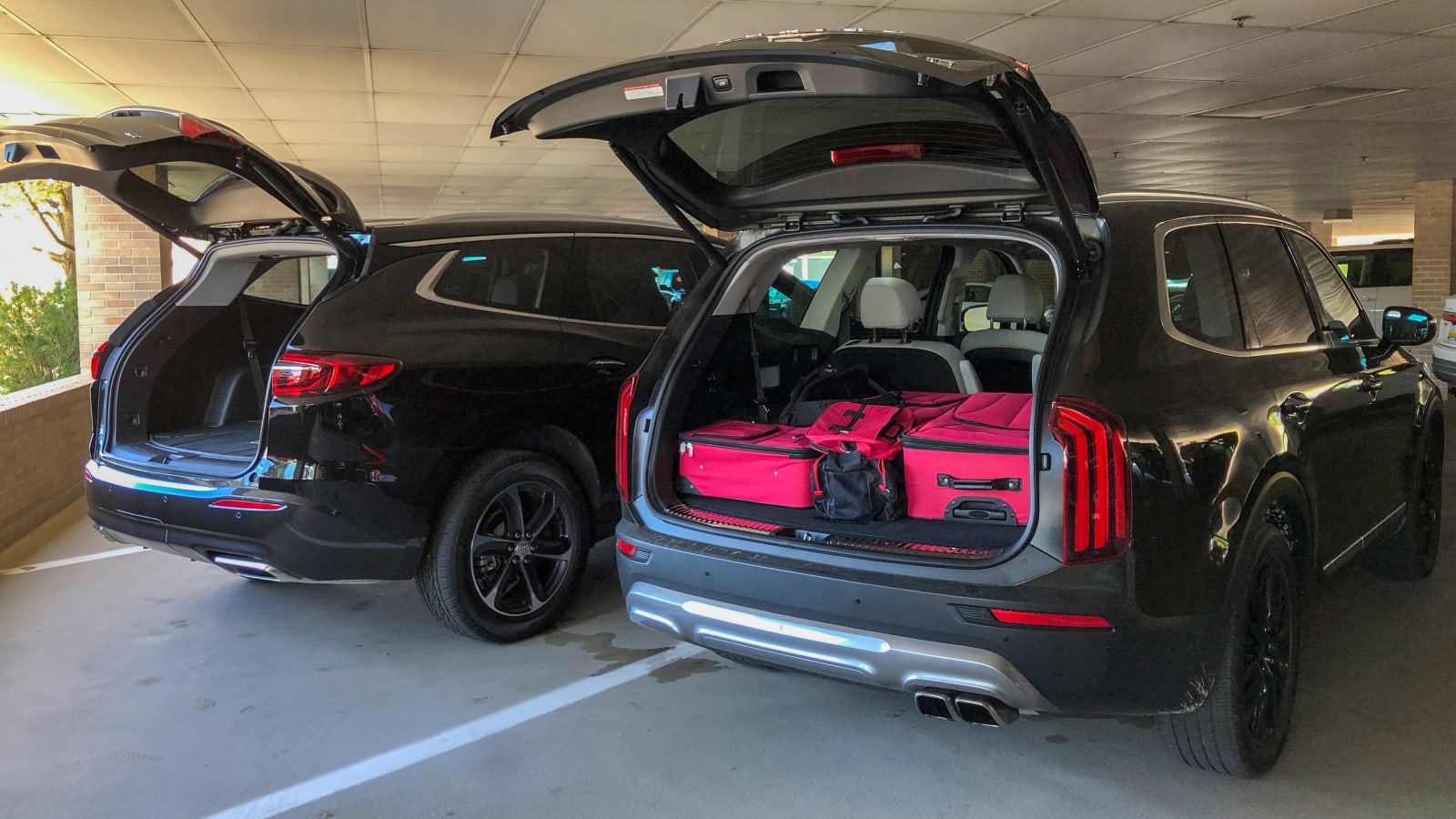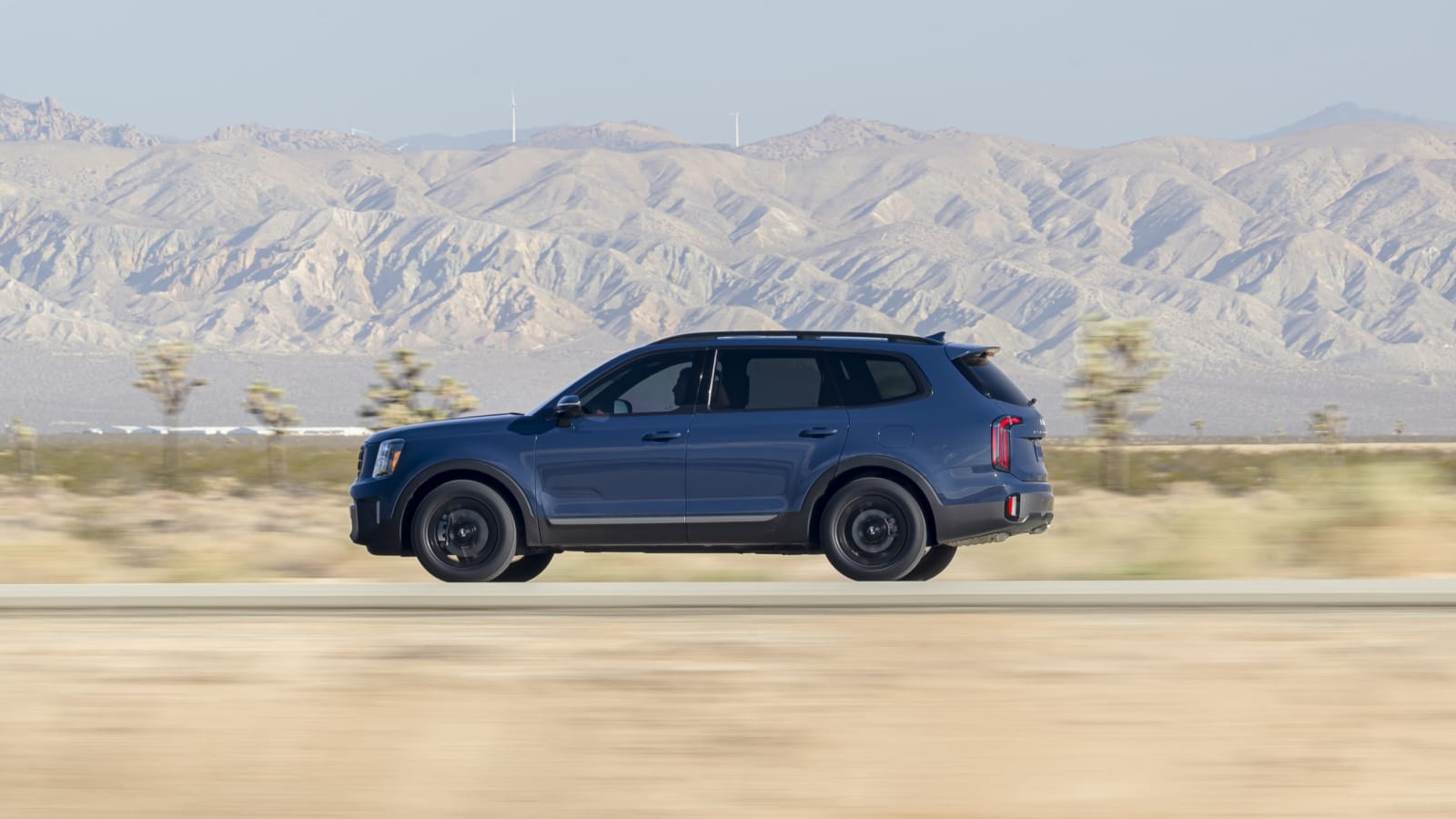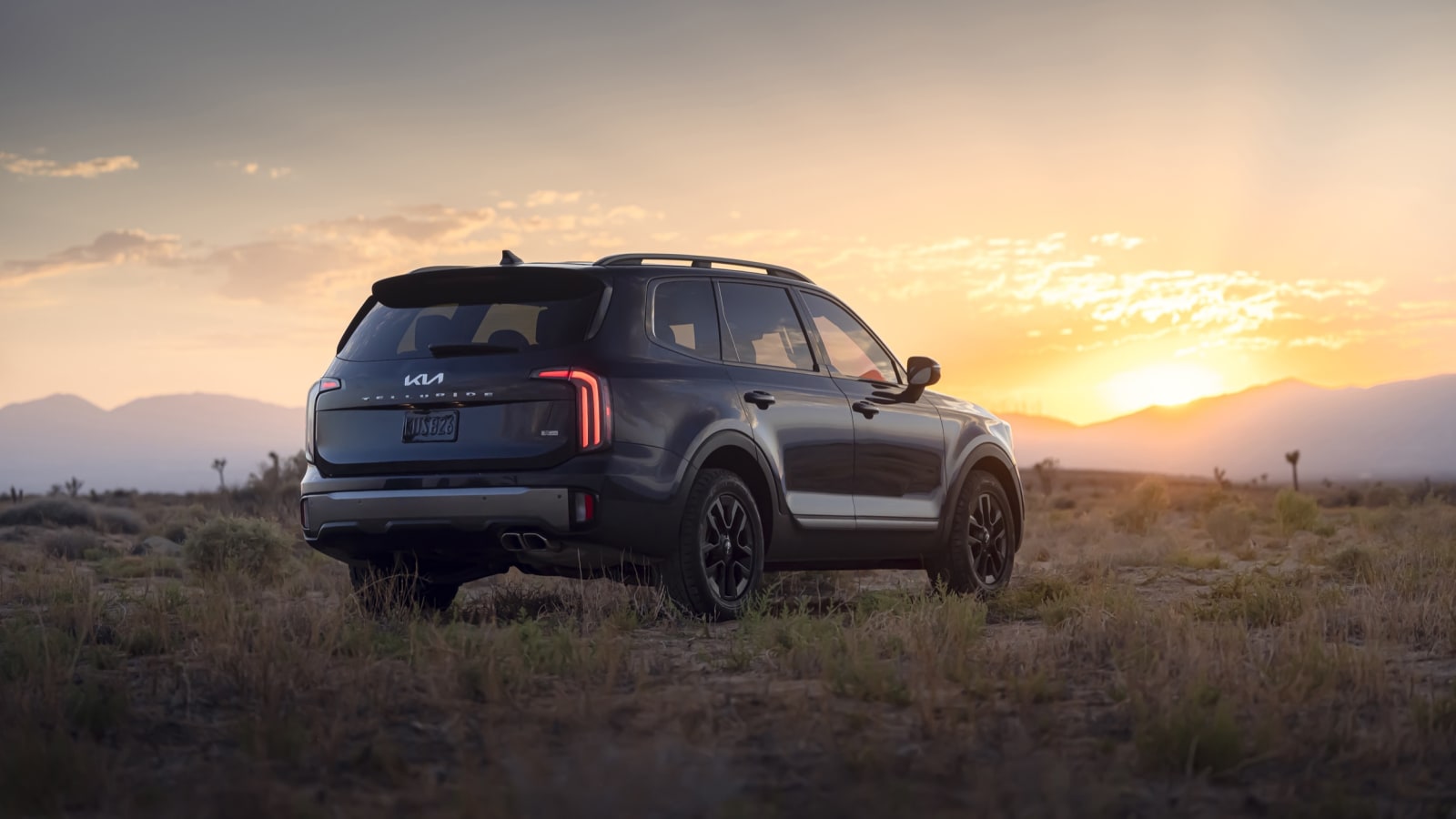Pros: Bigger-than-average third row and cargo space; user-friendly tech; handsome design; excellent value
Cons: No hybrid powertrain available
The 2023 Kia Telluride three-row SUV, already a well-deservedly popular model, has received a number of thoughtful and useful updates for the 2023 model year that make it even more compelling. Updated styling, improved tech and convenience features, plus the addition of new ruggedized trim packages are all reasons to take yet another look at this excellent value of a capable family crossover.
This all adds upon what already made the Telluride our top-recommended three-row family SUV, and keeps it as such for 2023. It’s a practical and spacious vehicle, with three rows of seating that is each big enough for adults. That’s not always the case in this segment. There’s also copious cargo room. The safety tech actually works well, and doesn’t infuriate the driver. Same goes for the infotainment tech. Perhaps the only drawback is the lack of powertrain choices. There’s a naturally aspirated V6 – that’s it – in either two- or all-wheel drive. No hybrid options, no turbo options … just a solitary, solid-but-unextraordinary engine you get no matter what you’re willing to pay. If that’s an issue, and you can sacrifice some space, look to Kia’s smaller Kia Sorento that’s available in regular and plug-in hybrids.
Some customers may also have been disappointed by the availability of the Telluride in 2022 — the model’s demand and global supply issues across the automotive industry meant it could be hard to come by. Still, Kia managed to sell more Tellurides in 2022 — just shy of 100,000 in the U.S. — than in 2021, and is increasing production capacity to 120,000 units a year. You should have an easier time finding one in 2023.
Interior & Technology | Passenger & Cargo Space | Performance & Fuel Economy
What it’s like to drive | Pricing & Trim Levels | Crash Ratings & Safety Features
What’s new for 2023?
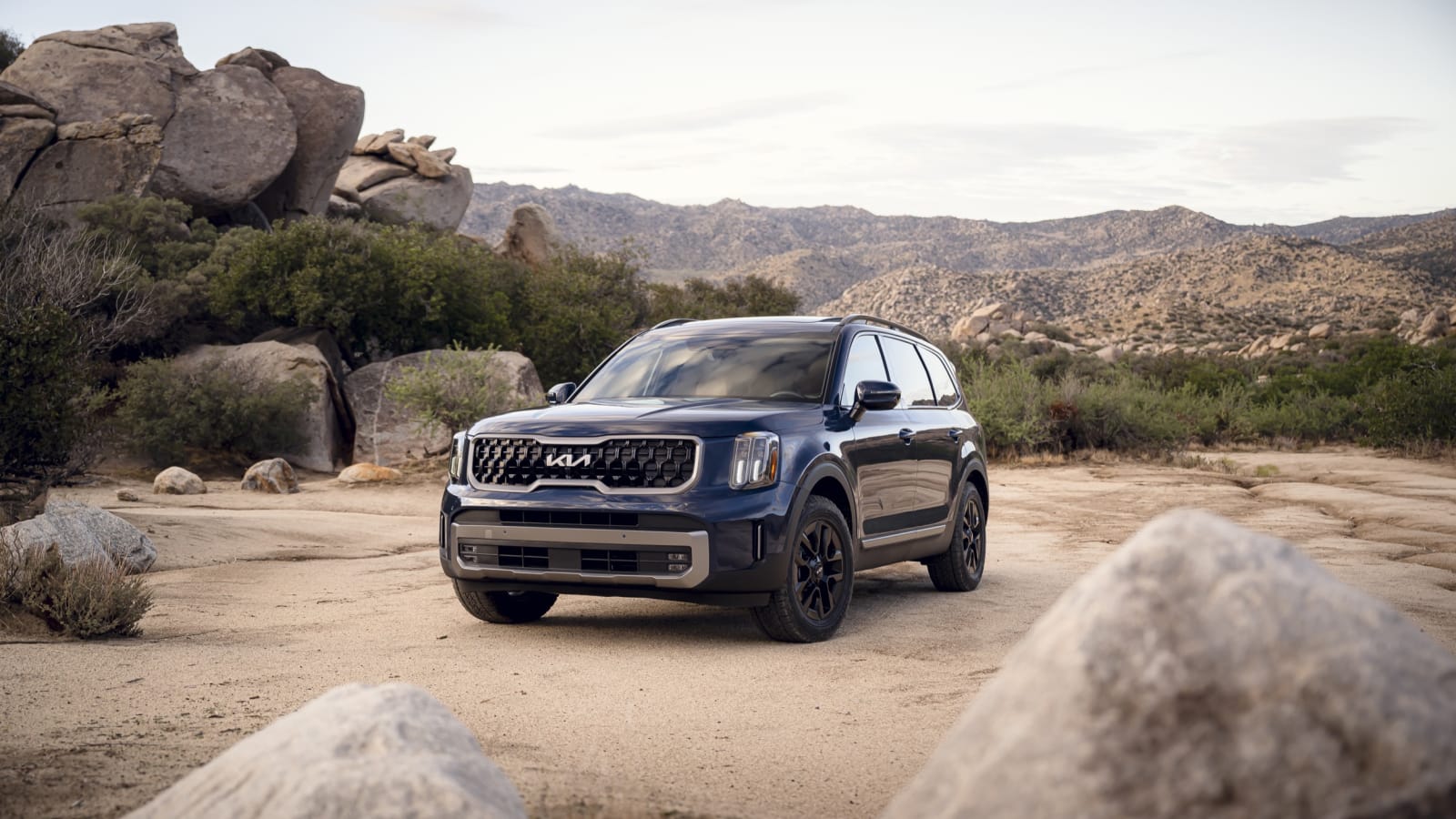
The 2023 received a midcycle refresh, including a facelifted exterior, new wheel designs for each trim level, three new paint colors and some interior tweaks for the dash, vents and steering wheel. A 12.3-inch infotainment display is now standard across trims, and SX and SX Prestige trims gets a standard dual infotainment and digital instrument panel under a single sheet of curved glass. In the EX trim and up, the rearview mirror becomes a digital camera display with the flip of a lever. The driver assistance suite has been updated with new standard features, and Kia’s more advanced Highway Drive Assist 2 adaptive cruise control system is standard in SX and up. The wireless charging pad has been made slightly bigger to accommodate a newer, larger generation of cellphones. Each row of seating gets USB-C charging ports.
New X-Line and X-Pro packages are available on certain trims, both with standard all-wheel drive, a Tow mode and a 0.4-inch increase in ground clearance, for a total of 8.4 inches. The X-Line replaces the Telluride Nightfall Edition, and is available as an upgrade to the EX, SX and SX Prestige trim levels. It gets a unique 3D mesh grille, body-color door handles, unique 20-inch wheels, raised roof rails. The X-Pro, available for the line-topping SX and SX Prestige trims, gets all the X-Line fixings, swaps in 18-inch black wheels wrapped in Continental all-terrain tires, and the suspension is tuned for “additional compliance.” It gets “X-Pro” badging and seat embossing, plus an extra 110-volt plug in the cargo area. Finally, its tow rating bests the other Tellurides by 500 pounds, at 5,500, thanks to an upgraded fan for improved cooling.
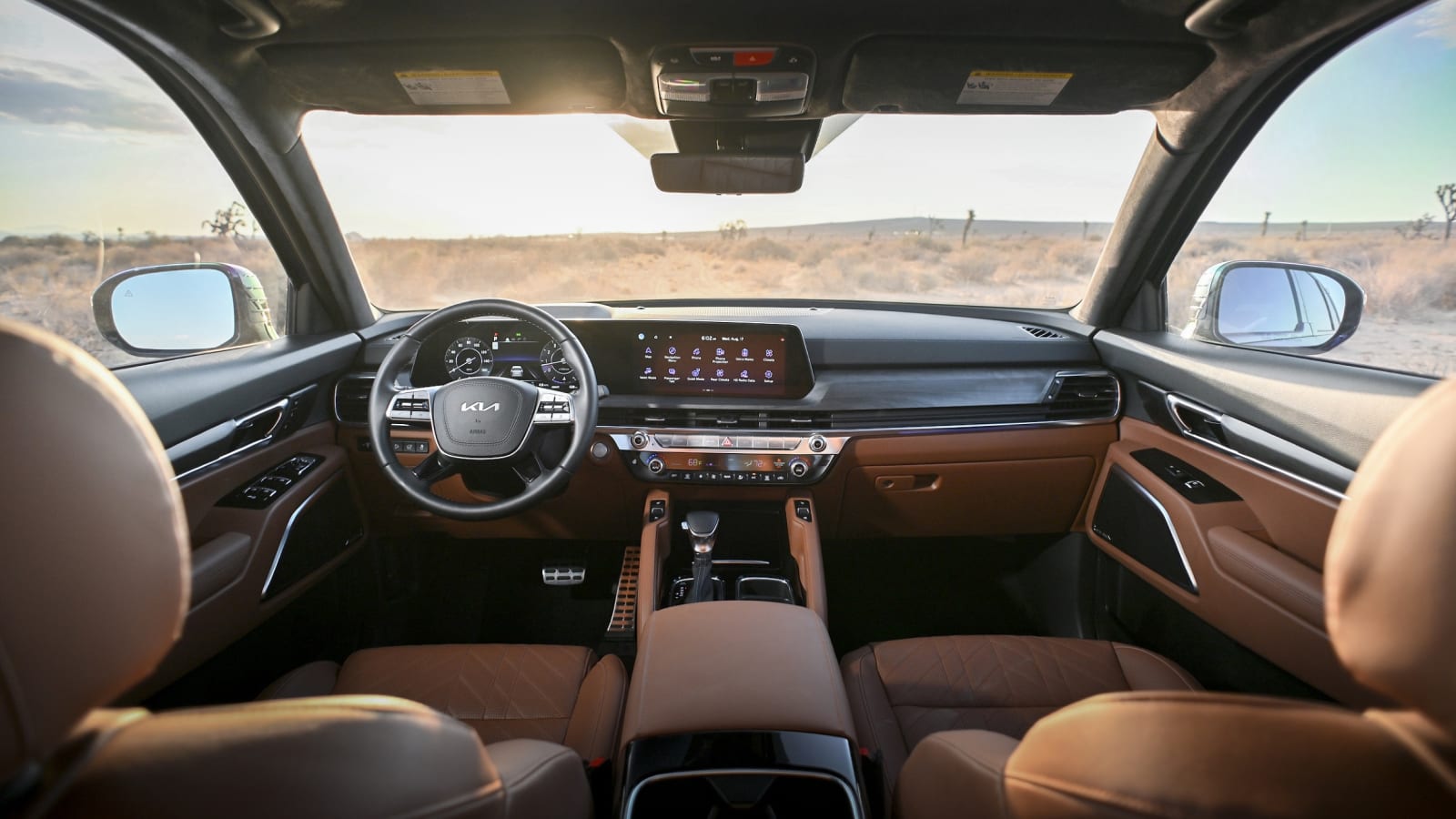
What are the Telluride interior and in-car technology like?
Admittedly, we’ve only had contact with the highest Telluride models that boast soft leather, high-quality trim materials, and a generally luxurious ambience that trumps nearly everything else in the segment (it’s a coin flip between it and the mechanically related Hyundai Palisade). It also costs less than range-topping rivals that actually have less equipment.
Now, will an LX and EX be as swank? No, but the general quality of plastics, switchgear and other materials should still be above average. Every Telluride is also extremely well equipped. Check out this pricing and features page on Autoblog for a full breakdown, but suffice to say, you don’t need to pay top dollar to get heated and ventilated seats, sunshades and an abundance of infotainment features.
Indeed, every Telluride comes standard with USB and USB-C ports, Apple CarPlay, Android Auto, satellite radio, and 12.3-inch infotainment touchscreen with navigation. Not only will this large screen impress your friends with its largesse, but it’s one of the more functional on the market as well. You still have to get one of the upper trims to add the dual-screen display, wireless smartphone charging, a head-up display and 100-volt plugs. The USB ports embedded in the backs of the front seats are unique, and shorten the distance between phone and port for those in the second row. The 2023 model also gets a number of USB-C ports throughout.
How big is the Telluride?
The 2022 Telluride is a large, three-row family crossover, eclipsing most competitors in terms of overall length and interior space. On paper, second- and third-row legroom is particularly generous, and we confirmed this in person by comfortably fitting 6-foot-tall people back-to-back in all three rows. That’s a rare feat for any vehicle, especially in terms of the third row. The way-back’s comfort and space are enhanced by its ample headroom and reclining capability, as well as the sliding second row (available as a bench or captain’s chairs). We also like the large rear quarter windows that help the Telluride’s third row avoid the claustrophobic feel of many competitors. Access to the third row is gained by pressing a button on the second-row captain’s chairs (if so equipped), which automatically slides and flips the seat forward. This may be conveniently simple, but the resulting gap isn’t that big.
Cargo space also betters that of most competitors, even with the third-row raised. There’s 21 cubic feet with all seats in place, versus the 16 to 18 range of most rival crossovers (it’s even more than the mechanically related Hyundai Palisade that’s jumbo in its own right). Now, as we discovered when cargo-testing the Telluride, achieving that 21-cubic-foot max capacity behind the third row is accomplished by removing the floor panel (stored outside the car) that adds 5 inches of depth, but nevertheless, the result is being able to stow more bags than any other three-row crossover besides the Chevrolet Traverse/Buick Enclave.
With all seats lowered, only the Ford Explorer and Chevrolet Traverse outdo the Telluride’s 87 cubic feet of maximum space.
What are the Telluride fuel economy and performance specs?
The 2023 Telluride still has a single powertrain option: a hard-working, naturally aspirated 3.8-liter V6 peaking at 291 horsepower and 262 pound-feet of torque, put to the wheels via an eight-speed automatic transmission.
The front-wheel-drive Telluride is rated at 20 miles per gallon in the city, 26 mpg highway and 23 mpg combined. With all-wheel drive, it gets 18/24/21 mpg. That’s not bad for a non-hybrid in this segment, but it’s not anything to write home about, either.
What’s the Telluride like to drive?
With no powertrain updates to go along with the refresh, driving the 2023 Telluride is going to feel familiar if you’ve driven any Telluride at all. The V6 is suitably powerful without being particularly quick (or slow), and the transmission stays out of the way. It certainly won’t blow you away, but rather falls in line with the rest of the Telluride’s driving experience: largely forgettable but also vice-free. You still have the various selectable drive modes to eke out either more throttle response (Sport) or range from your tank (Eco). There’s a Comfort mode to split the difference, a Smart mode that does the thinking for you, or a Snow mode for, well, snow.
The Telluride definitely doesn’t follow in the footsteps of the Stinger or other sporty Kias that demonstrate sharp handling and even driving fun. There’s lots of body roll, but it’s not uncontrolled, as the suspension sets itself nicely through a corner while maintaining composure over big bumps or undulations. The steering, at least in Smart or Sport modes, is also precise enough and provides confidence to the driver. The Comfort mode is too numb and allows too much play at speed. Really, the Telluride strikes a great balance between comfort and driver confidence that should be perfect for many. It also, importantly, doesn’t drive as big as its sizable dimensions would imply.
Driving the new X-Pro version on the road, if there was a difference from the extra modicum of ride height, the suspension tuning or taller sidewalls, it was too subtle to report on from our single first drive. It was still the familiar-feeling ride that leans more toward comfort than sportiness, soaking up bumps nicely. We did get to take it off-road, and while we can’t really compare it to the standard trims in this arena, it was surprisingly capable, even when one of the wheels would lift from the ground when crossing ditches and large ruts. The all-terrains found grip well, and the traction control works quickly to find even more footing when it’s needed. We wouldn’t hesitate to take this down some old logging trails or unmaintained county roads, but, honestly, we wouldn’t hesitate in the regular versions, either.
What other Kia Telluride reviews can I read?
2023 Kia Telluride First Drive Review: An established hit adds more to the menu
We drive the newly refreshed Telluride, and find the extra content and rugged-ish trims to be worth consideration
2020 Kia Telluride First Drive Review: The cool dad of crossovers
Our first complete drive of the 2020 Telluride, including a deeper dive into its design, interior functionality and driving experience.
2020 Kia Telluride Second Drive: Wife and son, won over
Senior Editor John Beltz Snyder spends some time in the family-friendly Telluride with his wife and son.
Kia Telluride Luggage Test
We find out how much stuff can fit behind the Telluride’s raised third-row seat.
Cargo Capacity Comparison Test: Kia Telluride vs Buick Enclave
In a previous test with different luggage, we compared it to the Buick Enclave. It, along with its Chevy Traverse sibling and the Volkswagen Atlas, are the only three-row crossovers with more space behind the third row than Telluride.
What is the 2023 Telluride price?
As ever, the Telluride drives a hard bargain. The base LX trim starts at $37,255 (including $1,365 in destination) with front-wheel drive, or $39,255 with all-wheel drive. It’s still very well equipped, with items typically not standard, including a heated steering wheel, 12.3-inch touchscreen display with navigation, adaptive cruise control with stop-and-go capability, and more safety features than usual (see Safety section below). Moving up in trims unlocks more convenience features, smarter tech and finer materials. The standouts here are the new X-Line and X-Pro trims, which increase ride height, add some rugged styling elements and, include all-wheel drive and, in the X-Pro, all-terrain tires and a higher tow rating. Each is offered with differing degrees of equipment (EX X-Line and SX Prestige X-Line, and then the SX X-Pro and SX Prestige X-Pro). The luxurious, line-topping SX Prestige trim has all the bells and whistles to go with a ritzier, more luxurious vibe.
See the price breakdown below, all including the destination charge, and read more about trims, pricing and features on Autoblog.
- LX FWD: $37,255
- LX AWD: $39,255
- S FWD: $39,155
- S AWD: $41,155
- EX FWD: $42,855
- EX AWD: $44,855
- EX X-Line: $47,050
- SX FWD: $47,055
- SX AWD: $49,055
- SX X-Line: $50,450
- SX X-Pro: $51,450
- SX Prestige: $51,955
- SX Prestige X-Line: $53,350
- SX Prestige X-Pro: $54,350
What are the Telluride safety ratings and driver assistance features?
Standard driver assistance features include forward collision warning and automatic emergency braking with pedestrian and cyclist detection, rear cross-traffic collision avoidance, lane-keeping steering assist, blind-spot warning, rear parking sensors, a driver inattention warning system, rear occupant alert, safe exit assist and adaptive cruise control with stop-and-go capability and lane-centering steering assist (Highway Driving Assist). The SX trim and higher add a blind-spot camera (a live video feed pops into the gauge cluster showing your blind spot when a turn signal is active), the Highway Driving Assist II system (adds automated lane changes to the adaptive cruise control plus machine learning that allows the system to adapt to your driving style), improved forward collision avoidance features for more driving situations (junction crossing, lane changing, etc.), forward parking sensors, reverse automatic emergency braking and surround view parking cameras.
While most competitors offer features like these, the Kia/Hyundai systems are better than most. The available, enhanced blind-spot monitoring system included in the SX is also better than the norm. We named it Autoblog Technology of the Year for its comprehensive, effective and not annoying layers of features designed to make lane changes safer and easier.
While the 2023 Kia Telluride hasn’t been crash tested by third parties as of this writing, we don’t expect it to change from the 2022 model’s ratings. The 2022 Telluride received five out of five stars for overall and side crash protection from the National Highway Traffic Safety Administration (NHTSA), and four stars for front protection. The Insurance Institute for Highway Safety named the 2022 Telluride a Top Safety Pick for its best-possible crash protection and crash prevention scores (though its side crashworthiness dropped from a “Good” to a “Marginal” rating as a result of the IIHS updated its testing procedures). Its base headlights got a “Poor” rating, which is typical, while its available upgrade headlights got an “Acceptable” rating.
Related video:



